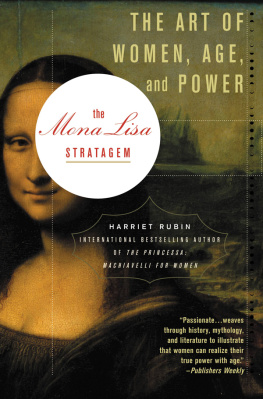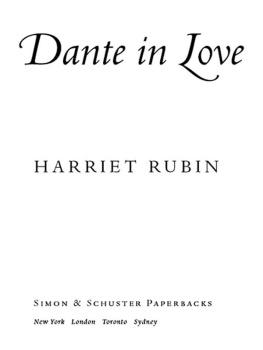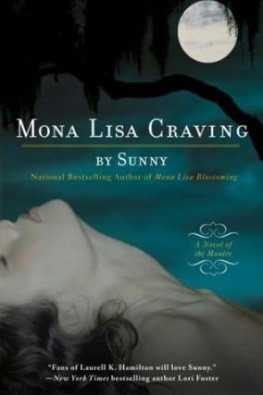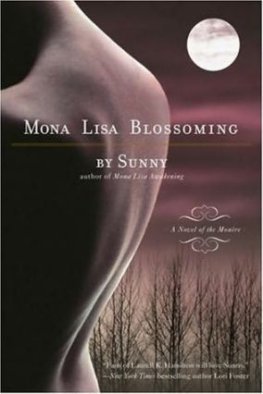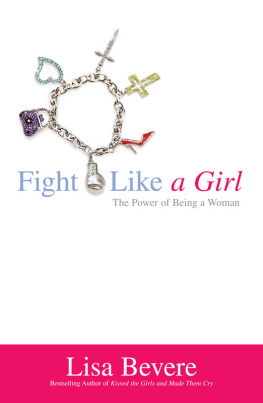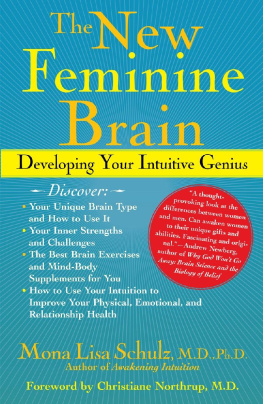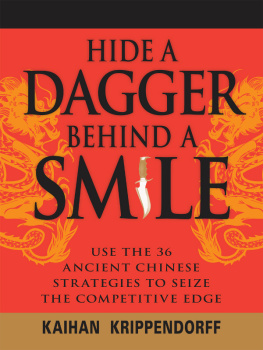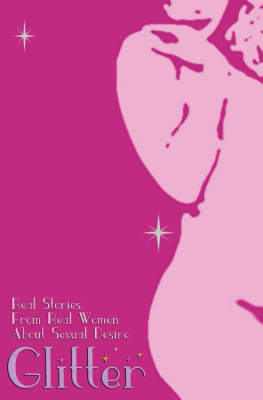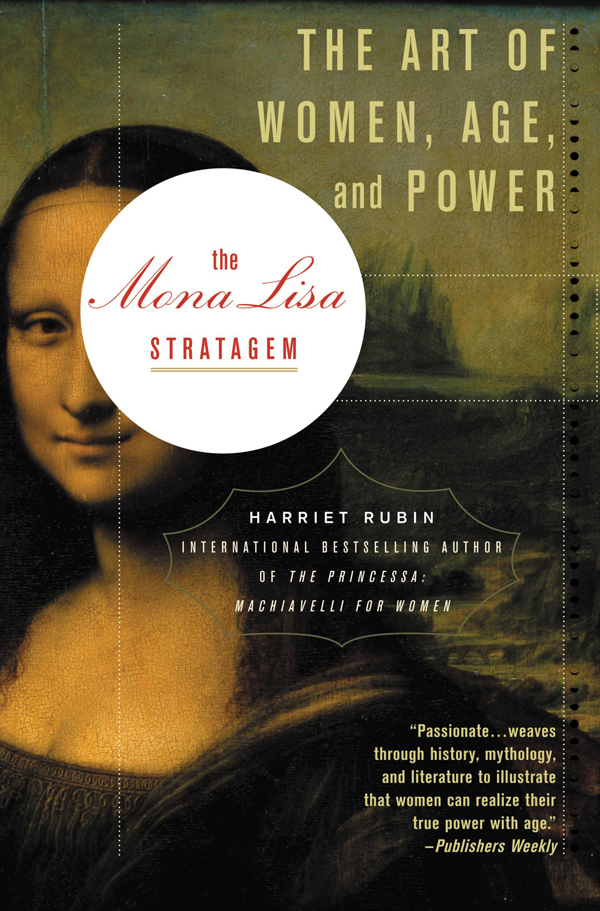Copyright 2007 by Harriet Rubin
All rights reserved. Except as permitted under the U.S. Copyright Act of 1976, no part of this publication may be reproduced, distributed, or transmitted in any form or by any means, or stored in a database or retrieval system, without the prior written permission of the publisher.
Warner Books
Hachette Book Group USA
237 Park Avenue
New York, NY 10017
Visit our Web site at www.HachetteBookGroupUSA.com.
First eBook Edition: April 2008
ISBN: 978-0-446-53650-9
Also by Harriet Rubin
The Princessa: Machiavelli for Women
Dante in Love: The Worlds Greatest Poem and How It Made History
For Mona Rinzler
And for Betty Sue Flowers
Every age bears its fruits; its all in knowing how to harvest them.
The answer is, in maturity. Founding fathers, old masters, and statesmen-presidents are vastly different from young go-gettersas different as lightning is from a lightning bug, to quote Mark Twain. Bach took his greatest leap of faith in maturity, creating music for an instrument, the clavier, not yet invented; and the founders wrote a Constitution that would mature over generations. Mature is a set of qualitiesan adjectivebut it is also a verb: to bring something to ripeness. Whenever Time moves unbearably fast, maturity becomes the corrective against disasters. Who are the experts on maturity but women?
You hold in your hands a Prince for grown-ups, an Art of War on how to face the last big enemy, Time, and Mortality, its evil twin. Women have perfected maturity: they reach that state sooner and enjoy it longer. This, then, is the first study of leadership for men and women in which the performance benchmarks are those of mature women. John McCain could, for example, take a lesson from Condoleezza Rice, who gets hyperarticulate and bristly when she is mad, but not bitchya style perfected by Elizabeth I, whose five-decade rule made England the center of the civilized world. Or Oprah, whose anger and ambitions often have a dignity like that of Golda Meir, the mature master-builder of national pride. Men, listen up: throughout history, great careers evolve into feminine endings.
The world itself may be evolving into a feminine ending: an ancient Sanskrit prophecy holds that at zero hour women will take power to avert the Earths demise. In troubled, macho countries, women are being elected to the highest political offices because they represent change.
Which brings us to the great Leonardoartist, engineer, alchemist, tutor to Renaissance kings: why, in his own maturity, did he hitch his star to the image of a woman, one of the most familiar and yet most mysterious ever seenan icon that has kept him alive and venerated for more than five hundred years?
Jackies Immortal Godmothers
Or, what a young woman sought in unwrapping the gifts of maturity
A just-picked plum Jackie Kennedyfresh and firm and all of thirty-one, new mistress of her husbands White Housedeveloped an obsession for a chubby glamourpuss named Madame de Maintenon who was well past menopause when she secretly married a king (Louis XIV). It is said that to get at a French king, you had to wiggle through a wall of women. All the more extraordinary, then, that at the center one should find this grandmama, as if that word were adequate. At the age of seventy-five Madame complained to her priest that the king insisted on sex with her every day, sometimes several times. Madame had a commanding and seductive presence that was more irresistible than when she was young and lithe. She made herself the central figure wherever she appeared. The king who took as his emblem the midday sun felt humbled and overshadowed by her and suddenly aware of his own mediocrity. In a court of pose and pomposity, she remained modest, spiritual, and compelling.
Its obvious why a person might covet the insights of age and power late in life, but at thirty-one? Jackie wanted to get a head start on the practices of power at its greatest. Power is the most intoxicating thing in the world, and the most intoxicating power comes with maturity and the confidence of having seen and done everything. When one is stirred by a resurgence of creative energy rivaling that of earlier decades, the challenge lies in knowing how to channel that power to the best possible ends.
But a wizened old hen like Madame? Exactly like Madame! She was no slave to manbooze; she had love but was also free. At Madames age, she could feel like a woman but luxuriate in the full force of her own mind, just like a man. She could be sour when cranky opinion moved her and an enlightened influence when truth was at stake. Her power went beyond having a king fall at her feet. A dozen or more women just like her became the original chattering classes: they opened salons in their homes, shaped the agendas for talk, lured into their midst the bright minds of the time, and used these conversations to move ideas through the society. The ideas instigated by these vintage women and impregnated into men in high governmental and political positions formed a society distinguished by its insistence on truth and beauty. The Paris of the eighteenth-century salonistes became the center of the world and the inspiration for the French Revolution. Ben Franklin wooed the salonistes for their insight into politics and access to key figures. They had something going for them that had proved impossible even in their own youth, some magic formula that put them at the center like the noonday sun.
Power brokers who came after Madame de Maintenon established themselves at the center of the universe for one hundred years. Men today follow the principles of the Godfather. For a creative, less money-mad time, these women were Godmothers. They formed a loose confederation or matriarchycircles within circles of power. They talked not only with men but avidly with each other. Their unity, formed of their adroit construction of social platforms, made them figures to be reckoned with. They became an army of womena Taliban of womenout to reconstruct a society based on the most sublime peace, amor mundi: love of the world. They cherished people outside their families as they cherished members of their families. Because what one man or even one family could contain all they had to give? At an age when they might have disappeared into the shadows locked in isolation from a community of purpose, they took to the big stage of social, cultural, and political effectiveness. No wonder Madame captured the attention and admiration of the young Jackie Kennedy, who followed her example to invest herself as Americas queen, a position she held for decades, until her death, no matter who succeeded her as First Lady.
Godmothers like Madame were the ultimate strategists. They could focus their attention upon improving the world because they knew who the real enemy was. Time! A young woman may be hooked, her energies drained, by a difficult husband, a paranoid boss, a jealous friend, or her own nasty ninjas of troubled self-confidence. But in age, such minor enemies lose their edge. They no longer confuse and distract. Rather, in age, one may act from a position of strength to confront and then to create a truce with Time. Time is the thief of youth, beauty, and assurance. Anything Time stole from Madame, however, she was happy to let go of: the tiny waist, the smooth neck, and the flock of children off to feather their own nests. She knew where to find compelling substitutes for whatever she lost. Jackie, who could have had herself tutored in power by any of the men in her husbands presidential court, chose her teachers carefully. Her Godmothers had a seventh sense men lack:

